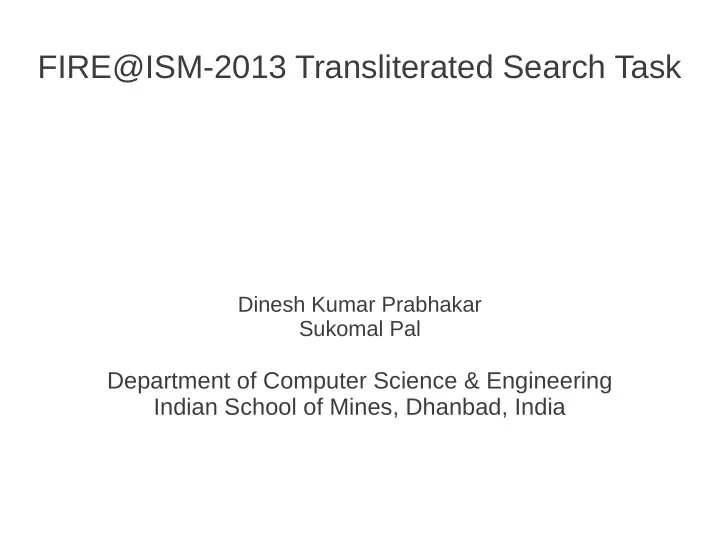

FIRE@ISM-2013 Transliterated Search Task Dinesh Kumar Prabhakar Sukomal Pal Department of Computer Science & Engineering Indian School of Mines, Dhanbad, India
Contents ● Introduction ● FIRE Task ● Solution ● Approaches ● Result ● Analysis ● Conclusion ● References 04/12/13 2
Introduction Transliteration: A process of writing a term/phrase/sentence of one language (e.g. Hindi) using script of another language (e.g Roman script as used in English) ( e.g.- yaaron sab dua karo <---> यारोः सब दुआ करो ) Two categories Forward : Phonetic presentation of terms in non-native script ( e.g. Hindi written using Roman script) Backward: Conversion of terms from non-native script to its native script ( e.g. Converting a Hindi phrase written using Roman script back to Devnagari script) 04/12/13 3
FIRE Task ● Task 1: Query Word Labeling – palak paneer recipe (i/p) – palak\H= पालक paneer\H= पनीर recipe\E (o/p) ● Task 2: Multi-script Ad hoc retrieval for Hindi Song Lyrics – Iss pyar ko main kya naam doon – List of song 04/12/13 4
Solution Query Word Labeling Phase 1: Classification – Dictionary based Classification – ML-based Classifier (MaxEnt) Phase 2: Transliteration – List-based 04/12/13 5
Approach-I ● Preprocessing – Assuming English wordlist contains sufficient data – Created 26 different text file (e.g.- a.txt, b.txt, ..., z.txt) ● Phase 1: Classification – List-based ● Phase 2: Transliteration – List-based 04/12/13 6
Algorithm 1. Input term from Test Document 2. Check first letter of term {A-Z,a-z} 3. Match term in corresponding Document 4. if match found 4.1. { Match term in E-H pair Document 4.2. if found 4.2.1. {Print term ,\H, word's native script from E-H pair} 4.3. else 4.3.1 {Print term ,\E}} 5. else 5.1. {Match term in E-H pair Document 5.2. if found 5.2.1. {Print term ,\H,=, native script from E-H pair} 5.3. else 5.3.1. {Print term, \H}} 6. end 04/12/13 7
Results ● Exact query match fraction (EQMF) = #(Quer. for which lang. labels and translits. match exactly)/#(All queries) ● Transliteration precision (TP) = #(Correct transliterations)/#(Generated transliterations) ● Transliteration recall (TR) = #(Correct transliterations)/#(Reference transliterations) ● Transliteration F−score (TF) = 2 × TP × TR/(TP + TR) ● Labelling accuracy (LA) = #(Correct label pairs)/(#(Correct label pairs) + #(Incorrect label pairs)) 04/12/13 8
Results Language Stats Metric ISMDhanbad Maximum Score Median Score Hindi Exact query match 0.0860 0.1980 0.0290 fraction 10 runs Exact 1584/2117 N. A. N. A. transliteration pairs match 5 teams Transliteration- 0.7253 0.8135 0.4486 precision #(True \H) = 2444 Transliteration- 0.6484 0.8125 0.4300 recall #(True \E) = 777 Transliteration- 0.6847 0.8130 0.4260 Fscore #(\N) = 232 Labelling accuracy 0.8780 0.9848 0.9540 N = Names Eng-precision 0.6853 0.9667 0.9302 and ambiguities Eng-recall 0.9138 0.9755 0.9640 excluded from Eng-Fscore 0.7832 0.9685 0.9019 analysis L-precision 0.9693 0.9906 0.9883 L-recall 0.8666 0.9894 0.9791 L-Fscore 0.9151 0.9900 0.9700 04/12/13 9
Analysis ● English wordlist in corpus is considerably high ● Out-of- Dictionary word will be treated as hindi word – (e.g.-peenekeliye\H) ● Named entity may come with correspoding transliterated word if it is in E-H pair file – (e.g.- khusbu khusbu\H= खुशॎबू ) – Why? – Since term is there in E-H pair document ● NER technique used X ● Context consider X 04/12/13 10 ●
Approach-II ● Preprocessing – Annotate “ E ” to english words and “ H ” to hindi term of E-H pair words (e.g.-tera H, khushboo H and good E, apple E) – Train the classifier with these annotion ● Phase 1: Classification – Using this classifier, terms are classified ● Phase 2: Transliteration – List-based 04/12/13 11
Algorithm 1. Input term from Test Document 2. Classify terms into E\H 3. if term is of E class 3.1. {Print term , “\”,class} 4. else 4.1. { match term in E-H pair Document 4.2. if found 4.2.1. {Print term ,class, term's native script from E-H pair} 4.3. else 4.3.1 {Print term ,\,class}} 5. end 04/12/13 12
Analysis bibi\H= बीबी ka\H= का maqbara\E paryatak\H guide\E ● maqbara\E wrongly classified – Why? – Less no of hindi term in training data ( in E-H pair document) ● paryatak\H equivalent transliteration is not here. – Why? – Out-of-dictionary (E-H pair document) 04/12/13 13
Conclusion ● Backward transliteration technique ● Our system has performed better for some of the metrics – (e.g.- EQMF, TP,TR and TF) – Why? – Equvalent transliterations was there ● There are some limitations of this system – (e.g. Named-entity may not be identifiable) – Why? – We haven't used any NER technique ● System may give unwanted transliteration for few terms (e.g.- koee koee/H= क े ) – Why? – Since it is there in E-H pair document 04/12/13 14
References 1. King, B., Abney, S.: Labeling the Languages of Words in Mixed-Language Documents using Weakly Supervised Methods In Proceedings of NAACL-HLT-2013, Atlanta, Georgia (2013) 1110- 1119 2. Gupta, K., Choudhury, M., and Bali, K.: Mining Hindi-English Transliteration Pairs from Online Hindi Lyrics, In Proceedings of the Eight International Conference on Language Resources and Evaluation (LREC '12), Istanbul, Turkey (2012) 2459-2465 3. Sowmya, V.B., Choudhury, M., Bali K., Dasgupta, T. and Basu, A.: Resource Creation for Training and Testing of Transliteration Systems for Indian Languages, LREC (2010) 4. Karimi, S., Scholer F., and Turpin, A.: Machine Transliteration Survey. In ACM Computing Surveys (CSUR), Volume 43 Issue 3, New York, USA (2011) 17:1-46 5. Dale, R.: Language Technology. Slides of HCSNet Summer School Course. Sydney (2007) 6. Stanford Classifier v3.2.0 – 2013-06-19 classification tool from Stanford University 04/12/13 15
THANK YOU 04/12/13 16
Recommend
More recommend